July 10th 2018
It’s only if you have children that you can name your favourite colour – after all, who else asks?
Yellow.
I used to paint my bedroom yellow so that it would be like waking up with the sun shining even if it wasn’t.
Back in the days when I thought I was going to be retiring rich and having my perfect boat built to order (38ft steel cutter) she was going to be called Shansi with a little painting of the Chinese Womble on the wind vane. I used to ghost-write Womble stories for Elisabeth Beresford who wrote the books. That’s how long ago it was.
And Shansi, the boat, was going to be bright yellow. Yellow hull, yellow decks, yellow mast – and caramel-coloured sails. Quite apart from the advantage of being somewhat noticeable, the good thing about a yellow steel boat was that the rust streaks would look quite attractive.
Well, plans are made to be changed and Samsara has a white hull and grey deck (not the right shade of grey but that is another story – and rather a tiresome one).
So, what was all this yellow I’ve been finding today?
About a hundred miles west of Ireland, the wind has been light all day and finally died away to nothing – well, not really nothing; I’m sure a lightweight racing boat with a full crew would have kept moving but Samsara is no lightweight and I draw the line at sitting up at the helm all night for the sake of putting on extra knot. Instead, I took everything down, shut the hatch and went to bed with two alarms leapfrogging each other.
It was the four O’clock alarm that was just in time to show the little boat icon on the plotter actually moving – but in the direction of Newfoundland instead of the Azores. That’s what you get with a windvane: The wind changes – and so does the heading.
In the normal course of events – four O’clock being somewhat before breakfast – I wouldn’t be up to doing much more than re-setting the steering. But this voyage is a bit like being in a pursuit race: The family arrive at Ponta Delgada at 1825 on August 1st and progress yesterday didn’t leave much leeway. So, pulling on foul weather gear over my pyjama shorts (clammy but convenient), I started crawling around the dew-covered deck setting sail which is not as easy when you’re pointing in the wrong direction and don’t want to start the engine because you’ve cranked so much grease into the stern gland it would be a waste it to turn the prop shaft.
So, headsail first to get her moving and a flow of air to help the mainsail go up without fouling the shrouds. Leeward lazyjacks off because it would definitely foul those. Then back to the cockpit and haul – yes, it worked. Don’t forget the topping lift. Then trim to course and, amazingly, bubbles start to move past the cockpit. The log wakes up and registers a speed – well, not exactly a speed – but movement, at least: 0.37kts…1.10kts…1.56kts…
Strange to think of this as progress but it definitely warranted breakfast in the cockpit.
Now, if you have looked at the “Good Health” page on this blog, you will see that the only reason I am able to do all this at my age is because of my collection of natural supplements (I don’t carry any pharmaceutical products at all – not even paracetamol). One of these supplements is a water-based curcumin (usually it’s only soluble in fat which means you have to cook with it to get it into your system). Mine comes in a little plastic capsule – slightly fiddly to pick out of the pot if you put everything in there together.
Which is, why, while picking out the Krill Oil and the Plant-Derived Minerals and so on, some of this stuff ended up on the floor. Of course, I picked it up. It’s not going to do me any good on the cockpit floor…
If I had known what was going to happen next, I would have been rather more careful about making sure I picked up everything – that I didn’t leave any capsules there to get squashed… and spew bright-yellow water-soluble curcumin into the deep, non-slip tread of my very expensive leather (not clammy) Dubarry boots.
It would have been fine if I had just stayed in the cockpit – or even gone below where I could tread the yellow all over the dark grey waterproof carpet.
But no, after my special (and quite delicious) cold porridge with sultanas and apple – and even a nectarine since, as usual, they had all ripened at once – it seemed that 1.56kts was no longer enough. The wind had veered some more and there was no doubt, she would carry the cruising chute.
That’s a palaver, I can tell you: Backwards and forwards to the foredeck: Unlock the forehatch from below, go up and open it, bring up the sail, back to the cockpit to pay off the sheet, scrabbling around getting the endless line on the right side of the sausage. Sometimes I don’t know why I bother – especially since, ten minutes later, the wind died and the whole thing was slopping about and threatening to wrap itself round the forestay. Safer to take it all down. Could leave it on deck – but better to do things properly, stick it below – and remember not to leave it sitting on top of the collapsible water can or that’ll leak…
So, you can see how much activity there was – and with so much of the action taking place in the rigging, it was hardly surprising that I never looked at the deck.
The grey deck (too pale by half) was now covered in random smears of bright yellow – and not just the deck (you can always scrub the deck). Every rope on the boat now seemed to be marked at intervals with bright yellow. At first glance I thought it was the manufacturer’s trademark – they haven’t made plain white ropes since the 70’s.
So, I scrubbed the decks. I knew what it was. I’ve had this trouble before. Also, I knew to scrub my boots first. But then, the more I scrambled around scrubbing, the more the stuff seemed to spread. I scrubbed the boots again, kneeling in the cockpit with a bucket of Atlantic to make sure I did a good job – that just seemed to make matters worse. In fact, when I crawled up to the foredeck to unhook the jibsheet from the anchor windlass, there seemed to be more than ever when I came back.
It was somewhere around this point that I discovered a second crushed capsule – still oozing its bright yellow cargo, had somehow got itself stuck to my knee…
It is now evening but not yet late enough for the other half of last night’s spaghetti putanesca. Samsara is under all plain sail and making four knots in the right direction. The hatch is shut because the North wind is chilly for July and somehow it seems like it’s been a busy day. I think I’ll add the other half of Sunday night’s tin of sweetcorn. Sweetcorn cheers you up.
It’s yellow.
_____________________________


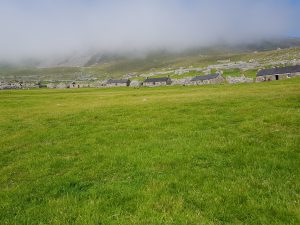
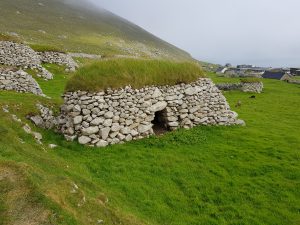
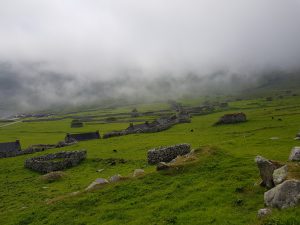
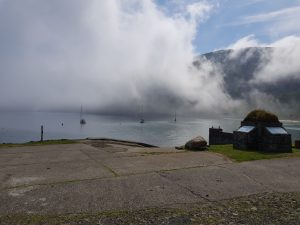
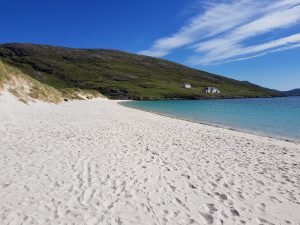
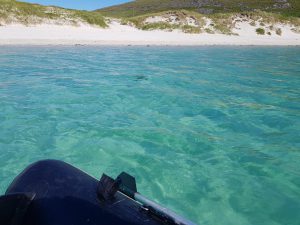

the email address contact@oldmansailing appears to be malfunctioning – permanent errors
Thanks for letting me know. I’ve now changed it to john@oldmansailing.com